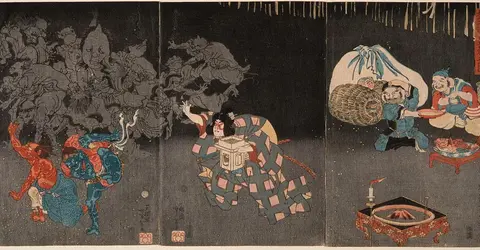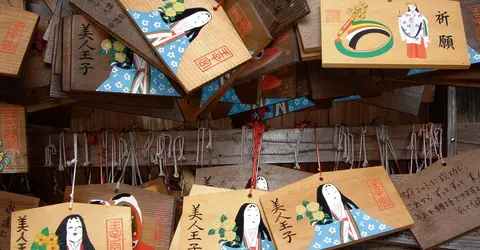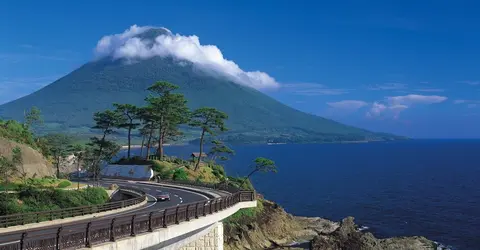Myths and legends of Japan: a plunge into the ancestral Japanese imagination

Momotaro against demons
Wikimedia
Japanese Myths
Legends have always been a means of rationalizing the world and explaining a culture's customs. Whether about the origin of the universe, the political establishment of the country, or the birth of festivities still celebrated today, the following myths have shaped Japanese cosmogony and are an integral part of local folklore.
Founding myths: the genesis of the world and primordial deities
- The creation of the Japanese archipelago by Izanagi and Izanami, the original divine couple, is recounted in the Kojiki and Nihon shoki, the oldest collections of Nipponese myths dating from the 8th century. Standing on the celestial floating bridge, they plunge a jeweled spear into the primordial ocean. As they withdrew it, drops of salt water crystallized, forming the first island, Onogoro-shima.
- Amaterasu, sun goddess born of Izanagi's left eye during her purifying ablutions after a sojourn in the underworld, is the supreme deity of the Shinto pantheon. Her father sent her to rule the celestial plains via the Celestial Ladder. She is the central figure of many founding myths and the ancestor of the imperial lineage.
- Tsukuyomi, god of the moon from the right eye of Izanagi, and Susanoo, god of storms and the sea from the nose of the creator god, complete this primordial divine triad. The incessant quarrels between Amaterasu and her brother Susanoo, an impetuous divinity, are at the origin of several significant mythological episodes.
The Shinto pantheon: a multitude of kami and nature spirits
- Inari, kami of harvests, rice, fertility and foxes, is one of the most popular and venerated deities throughout the archipelago. His messengers, the kitsune (foxes), are often depicted at his side.
- Hachiman, tutelary kami of war and legendary protector of Japan, is said to have favored the samurai in great battles. Son of Empress Jingū, he is also associated with agriculture and crop protection.
- Kannon, goddess of mercy with a thousand helping arms, comes in many shapes and forms, revering her universal nature as a compassionate benefactress watching over all beings.
- Every clan, mountain, river and sacred site has its own tutelary kami, who protects and infuses vital force into the natural elements and the human communities that worship her.
Demons, ghosts and supernatural creatures: the bestiary of Japanese folklore
- Oni, horned ogres with red or blue bodies, armed with iron clubs, embody demonic forces, sowing chaos and desolation. But some also act as protective guardians and vigilantes.
- Kappa, mischievous and sometimes evil aquatic creatures living in rivers and ponds, have the appearance of humanoid turtles with a water-filled cavity in their skulls, the source of their powers.
- The yūrei, spectres of the departed unable to find eternal rest, return to haunt the living to take revenge or right wrongs suffered.
- Yōkai is a generic term for all the monsters and supernatural spirits that inhabit Japanese beliefs, such as the kitsune (polymorphous fox), the tanuki (mischievous raccoon dog) or the bakeneko (cat endowed with magical powers).

Ema in an Amaterasu sanctuary
Flick/ jmurawski
Mythical and legendary heroes: warrior exploits and extraordinary powers
- Momotarō, the "peach-child" discovered in a huge fruit floating on a river by an elderly couple, becomes a valiant warrior who sets out to fight the demons of the island of Onigashima with his faithful animal companions (dog, monkey, pheasant).
- Master swordsman Minamoto no Yoshitsune is the epitome of loyalty and supreme martial skill. His legend recounts his childhood among the warrior monks of the Tengus, his victories against the rival Taira clan and his tragic end, betrayed by his jealous brother.
- Kintarō, the child of prodigious strength raised in the mountains by the witch Yamauba, impresses with his physical prowess and fearless character. He later becomes a loyal servant of the samurai Minamoto no Yorimitsu.
- Prince Yamato Takeru, son of Emperor Keiko, achieved great military conquests thanks to his courage, cunning and legendary Kusanagi sword. His exploits, recounted in ancient chronicles, make him a civilizing hero.

A road at the foot of Mount Kaimondake on Kyushu Island
JNTO
The impact of myths and legends on traditional and popular culture
- The Kojiki and Nihon shoki, "Chronicle of Ancient Facts" and "Annals of Japan", compiled in the 8th century by imperial order, transcribe the great mythological founding tales of the archipelago, from the age of the gods to the establishment of the imperial line descended from Amaterasu.
- Classical literature such as the Dit du Genji, nō and kabuki plays, and ukiyo-e prints abound with references to ancient myths, reinterpreted by each art form.
- Numerous mangas, anime and contemporary video games such as Princess Mononoke, Okami and Nioh revisit the themes and characters of Nipponese mythology, adapting them to today's sensibilities and perpetuating this ancient imagination.
- During traditional matsuri festivals, costumed parades, sacred rites and celebrations feature Shinto deities and legendary heroes, passing on this intangible heritage from generation to generation.
- See also: Tanabata Matsuri
Iconic mythological sites across Japan
- The Shinto shrines of Ise, dedicated to Amaterasu, are the holiest of Shinto shrines. Identically rebuilt every 20 years, these wooden edifices house the imperial treasures bequeathed by the solar goddess.
- The sacred island of Miyajima in the Seto Inland Sea, where the great vermilion torii of Itsukushima Shrine is enthroned, is considered the terrestrial home of the kami of the sea and harmony.
- Mounts Fuji and Ontake, revered peaks for centuries, embody in Shinto beliefs the abodes of essential divinities watching over the archipelago. Their slopes are home to numerous places of worship.
- Throughout the country, sea caves, purifying waterfalls and mysterious primeval forests are home to sacred natural sanctuaries where spirits, fantastic creatures and kami are revered by local communities.
A rich and unique mythology reflecting the Japanese soul
- Shinto cosmogony, a fusion of animism, shamanism and the worship of natural forces, expresses a profound respect for the harmony of nature's cycles, the souls of ancestors and the supernatural powers that govern the universe.
- Epic tales exalt the cardinal values of Japanese culture: courage, loyalty, honor and perseverance in the face of adversity, as exemplified by the adventures of heroes such as Yoshitsune and Yamato Takeru.
- The religious syncretism between original Shinto beliefs and the contributions of Buddhism, Taoism and Confucianism from China has shaped eclectic myths with multiple layers of symbolic interpretation.
- Beyond the marvellous and fantastic, the founding myths aim to explain natural phenomena such as earthquakes, eruptions and tsunamis, and to give meaning to the mysteries of human destiny, life and death, good and evil.















